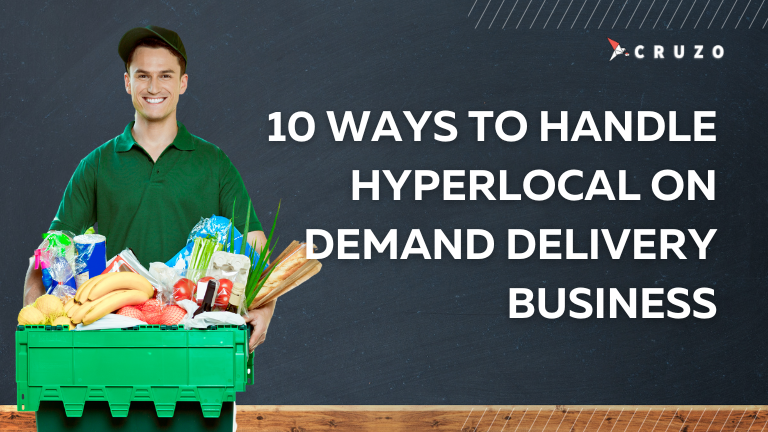
Ushering in an entirely new era of consumer expectations with speed, cost, convenience, the on demand entity is the NEXT BIG THING. All thanks to market giants like Amazon, Uber, Zomato, the consumer expectations have changed drastically all for the good. There is a monumental rise in the ever-changing demands of the consumers. They know what they want and when they want. Therefore, hyperlocal on demand delivery business is the BIG thing right now!
If an entity wants to keep the customers happy, then they need to provide a similar level of flexibility as offered by the market tycoons. Here’s why we have curated 10 ways to handle your on-demand delivery business that will help you achieve your desired goals for the customers as well as the ones who are involved in the entire process.
1- Convenient Scheduling Options
Convenient and accurate scheduling options are the need of the hour. One should know from where the inventory is, to fleet availability to availability of car space during curb-side pickup and much more. To handle an on-demand delivery business, you need requisite data on everything. Always make sure you have ample amount of flexible delivery times and fulfillment options like curbside, click & collect, same day delivery.
2- Flexible Delivery with Fulfilment Management
A fully digitized, in-sync, and impeccably coordinated delivery & fulfilment process is needed for any on demand delivery business. Receiving orders, allocating orders to drivers and then to the customer’s doorsteps will garner loyal customers. This needs a demonstrative visibility across the entire last-mile flow. Utilizing your existing resources will fulfill your orders cost-effectively. Ecommerce and delivery apps can help you with that.
For example, to ensure same-day pickup of orders, you must see where inventory is available and if there are enough retail staff to locate the item for pickup. In short, everything should be flexible and in-sync.
3- Automation
It’s very true that if you can’t get an order to a customer quickly, you will lose them. You must implant automation into every aspect of the delivery operation. From back-end systems to manager to driver, everything needs to be automated. An automated dispatching and routing system can make the right decisions based on your kind of business. Extended delivery times or alternative delivery options can be routed through automation.
Thus, these decisions must be in real-time, which requires automation technology & real-time integration among all the systems. Inefficiency rises in specified areas like dispatching. With an automated system in place, finding the right fleet or driver in time won’t extend any additional resources. An automated order batching will allow you to get more orders, quickly and seamlessly.
4- Alternative Order & Pick-Up Collections
To handle your on-demand delivery business hassle-free, strive to create an omni channel delivery and fulfillment strategy. Curbside pickup, click & collect, alternative pickup locations and many more are some of the features your business should possess. Enabling on-demand deliveries and pick-up will optimize the business models, once it is synced with the delivery operations.
5- CRM tools
CRM (Customer Relationship Management) tools must be embedded in any given on-demand delivery business which enables a smooth process of selling products and services online. CRM ensures a seamless communication between the seller, consumer and supplier. However, choosing the right CRM is not a simple task ; the on demand delivery business should make sure that the platform they choose has all the required functionality to meet your consumer needs.
6- Customer Alerts
Always look for solutions where you can send real-time notifications to customers when their order leaves the warehouse or the delivery boy has picked up their order or when their order has arrived. If it’s for curbside pickup customers, then they should get push notifications when their order is ready for pickup or information on where to meet to collect the order. From drivers running late to any unexpected happening, customers should get alerts via automated notifications. Hyperlocal on demand delivery business can have this delivery app for customers.
7- Order Fulfillment via local ship-from store & more
One can take full advantage of local stores and inventories to reduce costs. By using data analytics to understand the entire cycle of connected systems (inventory, warehouse, transportation etc) will b be the most cost-effective. Followed by, setting up your delivery flows and resources in order to offer better shipping prices, all in a competitive time frame.
8- Wide range of Delivery Networks & Multi-Fleet Dispatching
When orders are at peak, hiring third party delivery providers or crowdsourced fleets will provide additional manpower in times of need. You can use staff for multiple purposes by using grocery employees to stage orders in one half and turn them into delivery drivers for the next half. Herein you have to carefully track hours and manage payments per role.
9- Billing management
Being the most profitable segments, on-demand delivery businesses must have a wide range of payment modules. From credit cards to e-wallets to UPI, a business should amplify various billing processes to get the online payments done hassle-free. Always ensure to dedicate an ample amount of time to decide the kind of payment structures you’re going to implement in your business.
10- Exceptions handling
Exceptions like late changes in orders or change in address or driver availability in wee hours can disrupt the entire delivery ecosystem. Always make sure that data from all the teams are in sync in real-time so as to handle such unexpected problems. Once everything is in sync, exceptions won’t be affecting the customer’s experience.
Enhance your hyperlocal on-demand delivery business with Cruzo’s advanced SaaS solutions. Optimize operations, boost efficiency, and satisfy your customers with our cutting-edge technology. Contact us today at cruzotec.com to learn more and get started.








